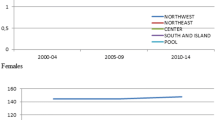Abstract
Background: Male breast cancer is rare, and little is known about state population–level patterns of incidence. The primary objective of this study was to determine the incidence of MBC in Florida in comparison with the Surveillance, Epidemiology, and End Results (SEER) program data.
Methods: Study data were obtained from the Florida Cancer Data System (FCDS). All males with pathologically confirmed invasive breast carcinoma diagnosed from 1985 to 2000 were included. Age-adjusted incidence rates, regional incidence rates, and descriptive statistics were calculated. Annual percent change (APC) for the study period was calculated with a linear model. Results were compared with the SEER data.
Results: A total of 1396 cases of MBC were identified. Age-adjusted incidence rates increased from 0.9 cases per 100,000 in 1990 to 1.5 cases per 100,000 in 2000. In 2000, the highest rates were in the age groups of 70 to 75 years (7.9) and ≥85 years (12.5). Infiltrating ductal was the most common subtype (92%); less common subtypes included mucinous (2%) and papillary (2%). Localized disease accounted for 45% of all cases, with regional disease in 33%, distant metastases in 7%, and unstaged in 15%. Most incident cases were diagnosed in the Palm Beach–Broward region (23%). The number of cases increased from 56 in 1985 to 132 new cases in 2000. The APC for this 16-year period was 2.0% (95% confidence interval [CI], 1.05–3.01; P < .005). SEER data indicated no change in MBC incidence rates (APC, 0.5; NS).
Conclusions: The incidence of MBC in Florida increased significantly between 1985 and 2000. This finding is discordant with SEER incidence data. Further epidemiologic studies are warranted to investigate regional variation.
Similar content being viewed by others
REFERENCES
U.S. Cancer Statistics Working Group. United States Cancer Statistics: 2000 Incidence. Atlanta: Department of Health and Human Services, Centers for Disease Control and Prevention, and National Cancer Institute, 2003.
Donegan WI, Redlich PN, Lang PJ, Gall MT. Carcinoma of the breast in males: a multiinstitutional survey. Cancer 2000; 89: 561–73.
Joshi MG, Lee Ak, Loda M, et al. Male breast carcinoma: an evaluation of prognostic factors contributing to a poorer outcome. Cancer 1996; 77: 490–8.
Gough DB, Donohue JH, Evans MM, et al. A 50 year experience of male breast cancer; is outcome changing? Surg Oncol 1993; 2: 325–33.
Guinee VF, Olsson H, Moller T, et al. The prognosis of breast cancer in males. A report of 335 cases. Cancer 1993; 71: 154–61.
National Cancer Institute. Surveillance, Epidemiology and End Results Program. Available at http://www.seer.cancer.gov. Accessed: April, 2004.
O’Malley C, Prehn A, Shema S, Glaser S. Racial/ethnic differences in survival rates in a population-based series of men with breast carcinoma. Cancer 2002; 94: 2836–43.
Percy C, van Holten V, Muir C. International classification of diseases for oncology. Geneva: World Health Organization, 1990.
Kleinbaum DG, Kupper LL, Muller KE. Applied regression analysis and other multivariate methods. 2nd ed. Boston: PWS Kent Publishing Co, 1988.
Kiatkowska E, Teresiak M, Filas V, et al. BRCA2 mutations and androgen receptor expression as independent predictors of outcome of male breast cancer patients. Clin Cancer Res 2003; 9: 4452–9.
Leibowitz SB, Garber JE, Fox EA, et al. Male patients with diagnoses of both breast cancer and prostate cancer. Breast J 2003; 9: 208–12.
Muir D, Kanthan R, Kanthan SC. Male versus female breast cancers. A population-based comparative immunohistochemical analysis. Arch Pathol Lab Med 2003; 127: 36–41.
Johnson KC, Pan S, Mao Y. Risk factors for male breast cancer in Canada, 1994–1998. Eur J Cancer Prev 2002; 11: 253–63.
Kelce WR, Stone CR, Laws SC, Gray LE, Kemppainen JA, Wilson EM. Persistent DDT metabolite p,p′-DDE is a potent androgen receptor antagonist. Nature 1995; 375: 581–5.
Author information
Authors and Affiliations
Corresponding author
Rights and permissions
About this article
Cite this article
Hodgson, N.C.F., Button, J.H., Franceschi, D. et al. Male Breast Cancer: Is the Incidence Increasing?. Ann Surg Oncol 11, 751–755 (2004). https://doi.org/10.1245/ASO.2004.01.001
Received:
Accepted:
Issue Date:
DOI: https://doi.org/10.1245/ASO.2004.01.001




